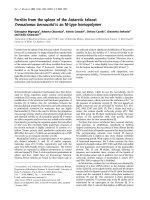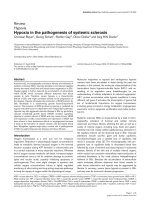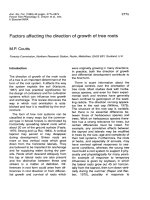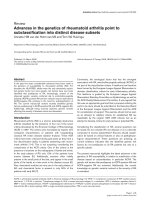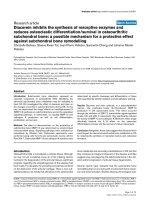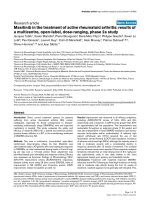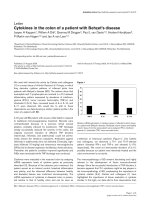Báo cáo y học: "Factors affecting the outcome of surgically treated non-iatrogenic traumatic cervical esophageal perforation: 28 years experience at a single center" docx
Bạn đang xem bản rút gọn của tài liệu. Xem và tải ngay bản đầy đủ của tài liệu tại đây (589.67 KB, 5 trang )
Onat et al. Journal of Cardiothoracic Surgery 2010, 5:46
/>Open Access
RESEARCH ARTICLE
BioMed Central
© 2010 Onat et al; licensee BioMed Central Ltd. This is an Open Access article distributed under the terms of the Creative Commons
Attribution License ( which permits unrestricted use, distribution, and reproduction in
any medium, provided the original work is properly cited.
Research article
Factors affecting the outcome of surgically treated
non-iatrogenic traumatic cervical esophageal
perforation: 28 years experience at a single center
Serdar Onat*
1
, Refik Ulku
1
, Kemal M Cigdem
2
, Alper Avci
1
and Cemal Ozcelik
3
Abstract
Background: We reviewed our experience with non-iatrogenic traumatic cervical esophageal perforations, paying
particular attention to factors affecting the outcome of such cases.
Methods: In total, 30 patients treated surgically between 1980 and 2008 for non-iatrogenic traumatic cervical
esophageal perforation in our clinic were reviewed.
Results: There were 25 male and 5 female patients with a median age of 27.5 years. The type of injury was external
trauma in 21 (70%) patients and endoluminal injury in the remaining 9 (30%) patients. The mechanism of injury was
gunshot in 16 patients, stabbing in 4, falling in 1 (extraluminal injury), and foreign body in 9 (endoluminal injuries). The
overall mortality rate was 16.6% (5/30). The mortality rate for extraluminal injuries was 19%, and for endoluminal
injuries was 11.1%. Mortality in patients treated within 24 h of sustaining injury was substantially less than in those for
whom diagnosis and treatment were delayed (12.5 and 21.4%, respectively). The mortality rate was 33.3% (3/9) for
patients with tracheal injuries and 9.5% (2/21) for those without tracheal injuries.
Conclusions: A treatment delay greater than 24 h, the presence of tracheal injury, or extraluminal perforation
significantly affected the outcome of surgically treated non iatrogenic traumatic cervical esophageal perforation.
Introduction
Perforation of the esophagus is a life-threatening condi-
tion. This is because the esophagus lacks a serosa and is
surrounded by a loose areolar connective tissue, which is
unable to prevent the spread of infection and inflamma-
tion [1]. Traumatic injuries to the esophagus encompass a
heterogeneous group of injuries that may be iatrogenic or
non iatrogenic. The cause of injury is ingested foreign
body in 12% and trauma in 9% of patients, while iatro-
genic injury remains the most frequent cause of esopha-
geal perforation (59%) [2]. Non-iatrogenic traumatic
cervical esophageal perforation is a difficult clinical
entity, and management requires a thoughtful and indi-
vidualized approach. The low incidence of this particular
problem leads to little clinical experience in surgeons.
Thus, we reviewed our experience with non-iatrogenic
traumatic esophageal perforation, paying particular
attention to factors affecting morbidity and mortality in
these patients.
Methods
The medical records of 30 cervical esophageal perfora-
tions due to non-iatrogenic trauma treated surgically in
our hospital between 1980 and 2008 were reviewed.
Patients in whom instrumentation was clearly and
directly responsible for the perforation (even in the pres-
ence of a foreign body), patients who died within 24 h due
to non-esophageal related complications, patients who
suffered from thoracic or intra-abdominal esophageal
injury, and patients treated non-operatively for cervical
esophageal perforation were excluded. Patients with cer-
vical esophageal perforations due to foreign bodies or
with external trauma treated surgically were included.
Demography, clinical presentation, diagnostic investi-
gations, mechanism of injury, associated injuries, time
interval between admission and definitive surgical care,
management, hospital stay, and morbidity and mortality
* Correspondence:
1
Department of Thoracic Surgery, Faculty of Medicine Dicle University,
Diyarbakir, Turkey
Full list of author information is available at the end of the article
Onat et al. Journal of Cardiothoracic Surgery 2010, 5:46
/>Page 2 of 5
rates were evaluated. The time interval from occurrence
of perforation to its diagnosis and treatment was catego-
rized as early (< 24 h) or late (> 24 h). Esophageal perfora-
tion was usually suspected on the basis of presenting
signs and symptoms. All patients underwent initial plain
neck and chest X-rays. When perforation was suspected,
a water-soluble contrast esophagogram was performed.
Due to the risk of aspiration pneumonitis, water-soluble
esophagograms were not used when tracheo-esophageal
fistulas were suspected. In doubtful cases, CT examina-
tion with oral contrast was performed.
The type of surgical repair performed (primary repair,
drainage alone, primary repair + drainage, primary repair
+ buttressed by muscle, or exclusion-diversion T-tube)
was recorded. Primary repair was performed by a sepa-
rate two-layer closure of mucosa and muscularis, using
interrupted polyglactin sutures. Tracheal repair was per-
formed using single-layer polyglactin sutures.
Postoperative care consisted of nil per os, nasogastric
tube replacement, and total parenteral or enteral nutri-
tion. Repetitive radiologic studies were performed when
necessary, depending on the patient's fever and clinical
condition. A follow-up esophagogram study was done at
the end of the fifth postoperative day, based on clinical
condition. The same regimen was continued for 10 more
days when leakage persisted. The process was repeated
until the perforation sealed completely. Multi-slice CT
with oral contrast was used primarily for small cervical
perforations. Serum C-reactive protein (CRP) and leuko-
cyte counts were used to evaluate the treatment model.
The χ
2
test was used for statistical analyses. Where
small cell size did not warrant the use of χ
2
, Fisher's exact
test was used. Data were also analyzed using Student's t-
test and the Mann Whitney U-test. A p value < 0.05 was
deemed to indicate statistical significance.
Results
The study included 25 males (83%) and 5 females (17%),
with a median age of 27.5 years (range, 2 71). Demo-
graphic data of all patients is summarized in Table 1. Of
the 30 patients, 21 (70%) suffered from extraluminal inju-
ries, while 9 (30%) had endoluminal perforations, due to
foreign bodies. Associated injuries included tracheal
injury in nine patients, hemopneumothorax in three, and
spinal cord injury in one. All nine patients who had com-
bined tracheal and esophageal injuries suffered from gun-
shots. Five of these nine patients with combined injuries
were explored through a collar incision, while four were
explored through an oblique cervical incision. The time
interval between esophageal injury and treatment ranged
from 4 h to 35 d. The interval between rupture and initial
treatment was less than 24 h in 16 patients (53.3%) and
longer than 24 h in 14 patients (46.7%).
Pain was the most common presenting symptom (26
patients, 86%). Other symptoms included dysphagia in 20
patients (66%), dysphonia in 10 (33%), and bloody regur-
gitation in 9 (30%). Subcutaneous emphysema was found
on physical examination and appeared radiographically in
23 patients (70%). Two patients had evidence of sepsis
preoperatively. Esophageal perforation was confirmed by
exploration of the neck in 10 patients (33.3%). The
remaining patients were diagnosed by esophagogram (15,
75%) and CT scan (5, 25%). A wide retropharyngeal space
was seen on a lateral cervical roentgenogram in three
patients (10%) due to abscess formation. Esophagoscopy
was performed in patients with perforation due to foreign
bodies. These patients had clinical evidence of esopha-
geal injury at the time of presentation. The perforation
was missed in three (16.6%) patients by esophagography.
In these doubtful cases, CT examination with low-tonic-
ity water-soluble oral contrast confirmed esophageal per-
foration.
Primary repair was performed in 19 patients. Surgical
approaches are listed in Table 1. In 14 patients admitted
to our clinic within less than 24 h, primary repair alone
was performed. Sternocleidomastoides muscle flaps were
used to buttress repairs in five patients (16.7%). Three
patients (10%) underwent near total exclusion with cervi-
cal T-tube esophagostomy. Three patients required reop-
eration due to leakage; two underwent redrainage, and
one underwent exclusion-T-tube esophagostomy.
Hyperalimentation was administered using total paren-
teral nutrition (n = 24), nasogastric feeding tube (n = 3),
or feeding jejunostomy and gastrostomy (n = 3). At dis-
charge, all patients were on a normal diet without dys-
phagia. The median hospital stay for all patients ranged
from 5 to 99 days (median, 21.5 days). Hospital stays were
twice as long in delayed patients, in those younger than
18 years of age, and in those with a gunshot injury, and
were significantly longer in patients with additional inju-
ries (p < 0.01) and in those surgically treated with exclu-
sion (p < 0.04). The median hospital stay for patients with
endoluminal perforation (16 days) was shorter than for
those with extraluminal perforations (26 days).
Five of the patients required tracheostomies (perma-
nent tracheostomy in one). The overall morbidity rate
was 43.3% (13 patients). Complications included sepsis in
five, anastomotic leakage in three, wound infection in
three, pneumonia in one, and injury of nervus laryngeal
recurrentis in one patient. The morbidity rate was signifi-
cantly higher in patients with gunshot injuries (p < 0.001)
and tracheal injuries (p < 0.001), and was two times
higher in male patients.
The overall mortality rate was 16.6% (5 patients; Table
2). The mortality rate in patients with associated tracheal
injuries was significantly higher than in those with no tra-
Onat et al. Journal of Cardiothoracic Surgery 2010, 5:46
/>Page 3 of 5
Table 1: Demographic data of all 30 patients, (NS: Non significant)
Factors Overall
(n = 30)
n (%)
Mortality
(n = 5)
n (%)
PMorbidity
(n = 13)
n (%)
pHospital
stay
(median
day)
P
Sex
Male 25(83.3) 5 (20) NS 12 (48) NS 21
Female 5(16.7) 0 (0) 1 (20) 22
Presentation Time
<24 h 16(53.3) 2 (12.5) NS 7 (43.8) NS 15.5 NS
>24 h 14(46.7) 3 (21.4) 6 (42.9) 28.5
Mechanism of injury
Gunshot 16(53.3) 4 (25) NS 12(75) 0.001 27 NS
Stab 4(13.3) 0 (0) 0 (0) 20
Fall 1(3.3) 0 (0) 0 (0) 12
Foreign body 9(30) 1 (11.1) 1 (11.1) 16
Associated injury
Present 13(43.3) 3 (23.3) NS 11(85) 0.001 35 0.01
Absent 17(56.7) 2 (11.8) 2 (11.8) 15
Tracheal injury
Present 9 (30) 3 (33.3) NS 9 (100) 0.001 35 0.01
Absent 21 (70) 2 (9.5) 4 (19) 16
Type of injury
Extraluminal 21(70) 4 (19) NS 12 (57.1) NS 26 NS
Endoluminal 9 (30) 1 (11.1) 1 (11.1) 16
Age
≤18 8 (26.6) 1 (12.5) NS 4 (50) NS 44 NS
>18 22(73.4) 4 (18.2) 9 (41) 21
Surgical Approach
Primary repair 19(63.3) 2 (10.5) 8 (42.1) NS 16 NS
Drainage alone 8 (26.6) 3 (37.5) NS 4 (50) NS 21.5 NS
Exclusion 3 (10) - 1 (33.3) NS 65 0.04
cheal injury. Although not statistically significant, mor-
tality in patients treated within 24 h of sustaining injury
was substantially less than in those for whom diagnosis
and treatment were delayed. Three patients with delayed
treatment died. Of those with gunshot wounds, two were
referred to our institution by another hospital. The cause
of delayed treatment was delayed presentation in one
patient who had ingested a foreign body. The mortality
rate was four times higher in patients with gunshot inju-
ries, and three times higher in patients who underwent
drainage alone as a surgical treatment. All patients who
died had sepsis and multi-organ failure after the develop-
ment of mediastinitis.
Discussion
The most common cause of esophageal perforation is
instrumentation; trauma covers only 10% of cases [3,4].
Although traumatic esophageal perforation is rare, its
management is a challenge for thoracic surgeons. Pene-
trating esophageal trauma occurs primarily in the cervi-
cal esophagus [5]. Sheely et al. performed a 22-year study
involving over 700 patients with penetrating neck
trauma, and found 39 patients (5.5%) with cervical esoph-
ageal injuries [6]. In our series, 66% of cervical esophageal
perforations were due to penetrating cervical injuries.
Ingestion of foreign bodies can result in perforation in
areas of anatomic narrowing, such as the cricopharyn-
Onat et al. Journal of Cardiothoracic Surgery 2010, 5:46
/>Page 4 of 5
geus, the impingement of the aortic arch and left main
stem bronchus, and the distal esophagus just proximal to
the lower esophageal sphincter [2]. In our series, 30% of
patients suffered from ingestion of a foreign body.
Diagnosis of esophageal perforation can be missed if
the surgeon overlooks its possibility. Plain film findings
vary, based on the location and cause of the perforation,
as well as on the interval between injury and radiographic
examination [7]. Emphysema of the neck is common after
cervical perforation and can be detected clinically in 60-
95% of patients [7]. We observed emphysema in 70% of
our patients. The presence of cervical emphysema is sug-
gestive of a perforated esophagus and warrants further
diagnostic study with contrast esophagography. The
esophagogram is considered the best method for detect-
ing esophageal perforation. Esophagograms can produce
false negative results, at a rate of 10-25% [8]. Of our
patients, 60% underwent esophagograms; of these, 16.6%
of the results were false negatives. Computed tomo-
graphic findings suggestive of esophageal perforation
include air in the mediastinal soft tissue surrounding the
esophagus, abscessed cavities adjacent to the esophagus,
and the presence of an actual communication between
air-filled esophagus, and an adjacent mediastinal or para-
mediastinal air-filled collection [9]. Additionally, CT is
particularly useful in follow-up after the initiation of
therapy [10]. In our series, CT revealed cervical perfora-
tions that had been misdiagnosed by esophagography in
three patients. We suggest that CT esophagography is the
best diagnostic tool for the evaluation of suspected
esophageal perforation. For penetrating trauma, it is very
important to establish the trajectory of injury. Diagnosis
and treatment was established in 10 of our patients by
neck exploration.
Early and prompt surgical intervention remains the
mainstay for treatment of cervical esophageal perforation
[11,12]. The goal of treatment must be to prevent further
soilage from the perforation, to eliminate infection pro-
duced by soilage, to restore the integrity and continuity of
the gastrointestinal tract, and to restore and maintain
adequate nutrition [4]. Primary closure, with or without
tissue reinforcement, is the preferable and most fre-
quently used approach for surgical management of
esophageal perforations [4]. Primary repair was per-
formed in 63.3% of the patients in our series. Classic
teaching cites time from perforation to diagnosis as a pre-
dictor of outcome, and various series have identified the
first 24 h as an acceptable interval for successful primary
repair [13]. Historically, the use of primary repair follow-
ing a delay in diagnosis of greater than 24 h has been
found to be associated with increased mortality [14].
However, some surgeons have recently attempted pri-
mary repair, regardless of the interval between the injury
and intervention [15-17]. The severe contamination and
inflammation that result from delayed treatment of
esophageal perforation may preclude primary repair at
the time of diagnosis [2]. We advocate drainage and pri-
mary suturing, if possible, for late presentations.
Because leakage after suture repair is a frequent occur-
rence, closure should be supported by a local tissue flap
[4]. Sternohyoid, sternothyroid, or sternocleidomastoid
muscles may be used to create the flap [3]. We used a
sternocleidomastoid muscle flap for cervical perforations
in five patients, and all survived.
If the esophageal leak is large and puts the tracheal
repair in jeopardy, the salivary stream can be diverted
with a "spit fistula," or T-tube. Reconstruction of the
esophagus can be done after the tracheal repair has
healed [3]. Some investigators have reported successful
clinical outcomes with the use of esophageal exclusion
and diversion techniques for the treatment of esophageal
perforation following late diagnosis and extensive con-
tamination [18]. In our series, three patients were treated
using this approach However, this technique should be
reserved for those patients in whom other approaches are
not feasible [4].
Weiman et al. pointed out that penetrating trauma
causes perforations primarily in the cervical esophagus,
and morbidity is usually due to associated injuries, such
as tracheal injuries [3]. In our series, morbidity and mor-
tality were high in patients who suffered from penetrating
injuries. Additionally, mortality in patients who had con-
comitant tracheal injury was higher than in those without
tracheal injury (33.3 and 9.5%, respectively). Associated
Table 2: Features of patients who died
Etiology Time interval for
treatment
Tracheal injury Type of treatment
1 Gunshot > 24 h Present Primary suture and
drainage
2 Gunshot < 24 h Absent Primary suture
3 Gunshot < 24 h Present Drainage
4 Gunshot > 24 h Present Drainage
5 Foreign body > 24 h Absent Drainage
Onat et al. Journal of Cardiothoracic Surgery 2010, 5:46
/>Page 5 of 5
tracheal injuries also prolonged the duration of hospital
stays in our series. The mortality rate for traumatic perfo-
rations ranges from 0 to 33% [8,13,15]. Overall, the mor-
tality rate was 16.6% in our series. The mortality rate in
patients treated with primary suturing was lower than in
those treated with drainage alone (10.5 and 37.5%,
respectively). The patients who died after drainage alone
were treated in the early 1990 s. The interval from perfo-
ration to initiation of treatment is a crucial determinant
of outcome after esophageal perforation. Although
advances in antibiotic therapy and critical care have
reduced complications following delayed diagnosis, a
delay in treatment of greater than 24 h is still associated
with an increase in mortality [13]. Prompt diagnosis and
treatment of esophageal perforation is essential for a
favorable outcome. Delay in treatment after esophageal
perforation has been found to be associated with higher
rates of both complication and mortality [19]. The mor-
tality rate in our patients treated before 24 h was 12.5%,
and it was 21.4% for patients treated after 24 h. Attar and
colleagues reported that survival decreased from 87 to
55% if treatment was instituted more than 24 h after the
onset of symptoms [13]. Nesbitt and Sawyers [20] noted
that if treatment was initiated within 24 h, the mortality
rate decreased from 56 to 13% over the following years.
In conclusion, although cervical esophageal perforation
is a potentially life-threatening condition, early diagnosis
and prompt treatment reduce morbidity and mortality.
Esophageal injury should be suspected when a gunshot or
stab wound is transcervical. Operative therapy remains
the mainstay of treatment; however, conservative man-
agement may be preferred for certain well-defined situa-
tions, and an esophageal T-tube may be used for late
perforations. Primary repair of the perforation site and
drainage offers the highest probability of survival. Clini-
cal outcome of these patients is influenced primarily by a
delay in diagnosis and the presence of associated injuries.
Competing interests
The authors declare that they have no competing interests.
Authors' contributions
SO conceived the study, participated in its design and coordination, wrote,
revised and submitted manuscript. RU participated in its design and coordina-
tion. KMC performed the statistical analysis and coordination. AA participated
in its design and coordination. CO participated in its design and revised the
manuscript. All authors have read and approved the final manuscript.
Author Details
1
Department of Thoracic Surgery, Faculty of Medicine Dicle University,
Diyarbakir, Turkey,
2
Department of Pediatric Surgery, Faculty of Medicine Dicle
University, Diyarbakir, Turkey and
3
Department of Thoracic Surgery Faculty of
Medicine Canakkale Onsekiz Mart University, Canakkale, Turkey
References
1. Panieri E, Millar AJ, Rode H, Brown RA, Cywes S: Iatrogenic esophageal
perforation in children: patterns of injury, presentation, management,
and outcome. J Pediatr Surg 1996, 31(7):890-895.
2. Brinster CJ, Singhal S, Lee L, Marshall MB, Kaiser LR, Kucharczuk JC:
Evolving Options in the Management of Esophageal Perforation. Ann
Thorac Surg 2004, 77:1475-1483.
3. Weiman DS, Walker WA, Brosnan KM, Pate JW, Fabian TC: Noniatrogenic
esophageal trauma. Ann Thorac Surg 1995, 59(4):845-850.
4. Jones WG, Ginsberg RJ: Esophageal Perforation: A continuing
challenge. Ann Thorac Surg 1992, 53:534-543.
5. Wu JT, Mattox KL, Wall MJ Jr: Esophageal perforations: new perspectives
and treatment paradigms. J Trauma 2007, 63(5):1173-1184.
6. Sheely CH, Mattox KL, Beall AC Jr, DeBakey ME: Penetrating wounds of
the cervical esophagus. Am J Surg 1975, 130(6):707-711.
7. Han SY, McElvein RB, Aldrete JS, Tishler JM: Perforations of the
esophagus: correlation of site and cause with plain film findings. AJR
1985, 145:537-540.
8. Flynn AE, Verrier ED, Way LW, Thomas AN, Pellegrini CA: Esophageal
perforation. Arch Surg 1989, 124:1211-1215.
9. Backer CL, LoCicero J, Hartz RS, Donaldson JS, Shields T: Computed
tomography in patients with esophageal perforation. Chest 1990,
98:1078-1080.
10. Endicott JN, Molony TB, Campbell G, Bartella LF: Esophageal
perforations: the role of computerized tomography in diagnosis and
management decisions. Laryngoscope 1986, 96:751-757.
11. Asensio JA, Chahwan S, Forno W: Penetrating esophageal injuries:
multicenter study of the American Association for the Surgery of
Trauma. J Trauma 2001, 50(2):289-296.
12. Gupta NM, Kaman L: Personal management of 57 consecutive patients
with esophageal perforation. Am J Surg 2004, 187(1):58-63.
13. Attar S, Hankins JR, Suter CM, Coughlin TR, Sequeira A, McLaughlin JS:
Esophageal perforation: A therapeutic challenge. Ann Thorac Surg
1990, 50(1):45-49.
14. Kim-Deobald J, Kozarek RA: Esophageal perforation: an 8-year review of
a multispecialty clinic's experience. Am J Gastroenterol 1992,
87:1112-1119.
15. Bufkin BL, Miller JI Jr, Mansour KA: Esophageal perforation: emphasis on
management. Ann Thorac Surg 1996, 61(5):1447-1451.
16. Okten I, Cangir AK, Özdemir N, Kavukcu S, Akay H, Yavuzer S:
Management of esophageal perforation. Surg Today 2001, 31:36-9.
17. Chao YK, Liu YH, Ko PJ, Wu YC, Hsieh MJ, Liu HP, et al.: Treatment of
esophageal perforation in a referral center in taiwan. Surg Today 2005,
35(10):828-32.
18. Ichikura T, Kawarabayashi N, Ishikawa K, Ikuta SI, Mochizuki H: T-tube
management of a major leakage of the cervical esophagogastrostomy
after subtotal esophagectomy: report of three cases. Surg Today 2003,
33(12):928-31.
19. Pate JW, Walker WA, Cole FH Jr, Owen EW, Johnson WH: Spontaneous
rupture of the esophagus: a 30-year experience. Ann Thorac Surg 1989,
47(5):689-692.
20. Nesbitt JC, Sawyers JL: Surgical management of esophageal
perforation. Am Surg 1987, 53:183-191.
doi: 10.1186/1749-8090-5-46
Cite this article as: Onat et al., Factors affecting the outcome of surgically
treated non-iatrogenic traumatic cervical esophageal perforation: 28 years
experience at a single center Journal of Cardiothoracic Surgery 2010, 5:46
Received: 24 March 2010 Accepted: 31 May 2010
Published: 31 May 2010
This article is available fro m: http://www. cardiothoracics urgery.org/con tent/5/1/46© 2010 Onat et al; licensee BioMed Central Ltd. This is an Open Access article distributed under the terms of the Creative Commons Attribution License ( ), which permits unrestricted use, distribution, and reproduction in any medium, provided the original work is properly cited.Journal of Cardiothoracic Surgery 2010, 5:46
